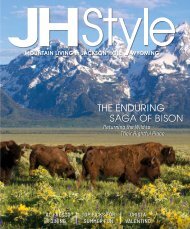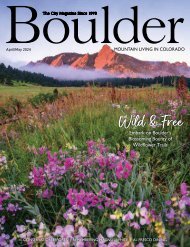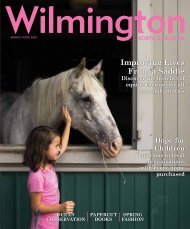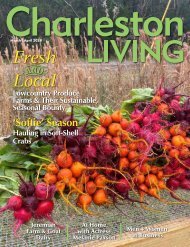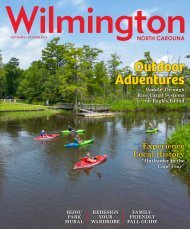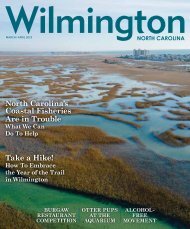Plateau Magazine June-July 2023
This issue we feature women entrepreneurs with locally run businesses and cowgirls who are protecting local animals. We also highlight protecting the land and fields that are important for bees and butterflies pollination. And for the foodies, check out our feature on the Highlands Tavern. Get outdoors with this issue, with our interview on legendary hiker Jennifer Pharr Davis.
This issue we feature women entrepreneurs with locally run businesses and cowgirls who are protecting local animals. We also highlight protecting the land and fields that are important for bees and butterflies pollination. And for the foodies, check out our feature on the Highlands Tavern. Get outdoors with this issue, with our interview on legendary hiker Jennifer Pharr Davis.
You also want an ePaper? Increase the reach of your titles
YUMPU automatically turns print PDFs into web optimized ePapers that Google loves.
nately, our rich native plant palette allows<br />
us to do this beautifully, with joy and<br />
abundance rather than tedious sacrifice.<br />
I’m an unabashed lover of plants and varied<br />
garden styles, not a native plant purist.<br />
There are many circumstances in which a<br />
well-mannered ornamental plant, known<br />
to remain in a cultivated space, can be a<br />
brilliant addition to a garden. That said, I<br />
cannot overstate the importance of incorporating<br />
natives into our landscapes. Beyond<br />
haphazardly installing indigenous plants,<br />
however, it’s essential that we advocate for<br />
natives with aesthetics and efficacy. Frank<br />
Lloyd Wright advised his architecture students:<br />
"Study nature, love nature, stay close<br />
Top:) Wide swaths of Cinnamon fern and Hayscented fern create a floor-level community at<br />
Southern Highlands Reserve; A tapestry of blue gentian, Heuchera americana, sedum and moss<br />
cover the ground in lieu of dirt or mulch.<br />
to nature. It will never fail you." Wright<br />
was teaching his students to derive inspiration<br />
from the essence of organic forms<br />
and naturally occurring relationships, not<br />
to copy exactly what one sees—that would<br />
simply be the woods. When we garden, we<br />
are intervening. Often, it’s a place that has<br />
been previously disrupted, and one goal is<br />
to restore the site in an appealing way. In<br />
nature, naked soil is almost always the undesired<br />
result of a temporary disturbance.<br />
Subsequently, the system restores the soil<br />
by allowing plants to reclaim that space via<br />
decomposition, germination and proliferation,<br />
especially critical for erosion mitigation<br />
in the mountains.<br />
Hiking trails are vibrant classrooms to<br />
learn effective arrangement for planting<br />
design. Plants always exist in groups, never<br />
as single members. John Muir observed,<br />
“When we try to pick out anything by itself,<br />
we find it hitched to everything else<br />
in the universe.” Similarly, Dolly Parton<br />
sang about interwoven plant communities:<br />
“The hills were alive with wildflowers…<br />
And the flowers I knew/In the fields where<br />
I grew/were content to be lost in the crowd.”<br />
Plants live in interconnected communities<br />
whose distribution and morphology perform<br />
particular ecological functions within<br />
site-specific conditions. Constrained<br />
resources give rise to distinct characteristics<br />
of a plant community—a shady rocky<br />
area is only hospitable to members that<br />
have co-adapted to share resources under<br />
those conditions. At home, we can discern<br />
constraints that help inform which community<br />
of plants will be appropriate for<br />
the site we have. As with language, poetic<br />
structure that restricts prose can create a<br />
perfect framework for harmony.<br />
The more I think about ecologically responsible<br />
gardening, I realize that rather<br />
than a purist, perhaps I’m a gardenist—<br />
an advocate for more plants and more<br />
gardens overall—plenty more, then triple<br />
whatever number that is. A successful and<br />
lush planting is always more appealing<br />
than a skimpy one. The ground layer, lowgrowing<br />
matrices of plants that preserve<br />
our soil and feed our ecosystem, is rarely<br />
populated sufficiently in traditional planting<br />
schemes. It’s summer, though, so the<br />
forest floor is covered with ferns, sedges<br />
and asters. Let’s walk these woods and<br />
hillsides to understand the elegant relationships<br />
within communities of organisms.<br />
Let’s seek, with humility, to emulate<br />
their harmony. P<br />
<strong>June</strong>/<strong>July</strong> <strong>2023</strong> | 61



